Safety first
The speed and creativity of your team are becoming increasingly important for your collective effectiveness. But these attributes require a psychologically safe environment, where candor and trust are permitted, and where everybody is encouraged to ask questions, voice disagreement and share ideas. In short, an environment where people can commit themselves fully!
Safety is a prerequisite not just to guarantee commitment and inclusion, but also to facilitate remote working. Edmonson and Hugander argue that it’s rooted in a voluntary approach, illustrated (for example) in the four cornerstones of good practice developed at appliance manufacturer SEB:
– Focus on what’s concrete: results. More than soft skills, results are an excellent way to inspire everyone to share ideas and solve complex problems. Talk about success stories among your different teams.
– Train individuals and teams: Help your employees develop their own skills, then work on them as a team.
– Encourage your people to visualize positive situations in which they dared to voice their opinion or ask that of others, which will then help them internalize these expected behaviors.
– Share and normalize your vulnerabilities. This will reduce your and your employees’ anxiety, and they will have the courage to do the same.
Your people need psychological security more than ever. Make it a priority, because it’s one of the essential elements that lie behind commitment.
“4 steps to boost psychological safety at your workplace“
by Amy C. Edmondson and Per Hugander (Harvard Business Review, 22 June 2021).
© Copyright Business Digest - All rights reserved




